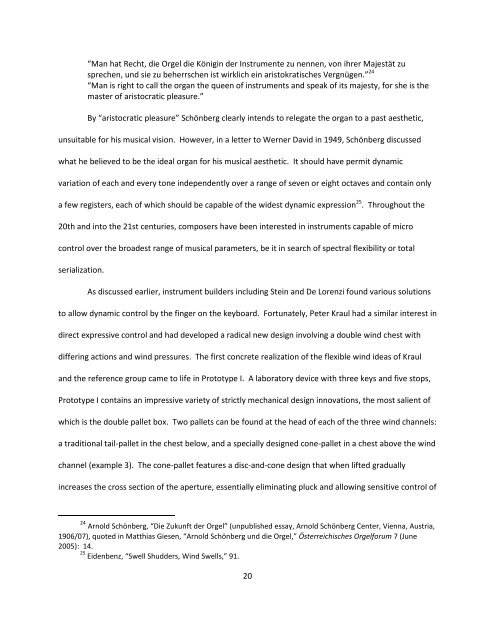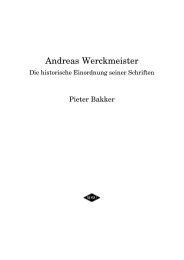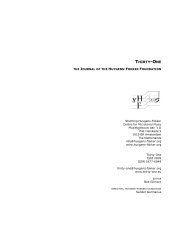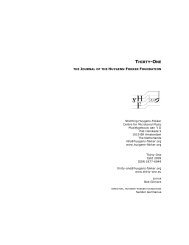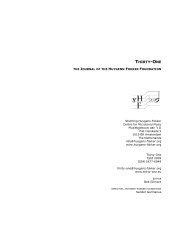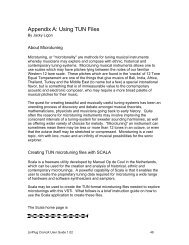Recent Organ Design Innovations and the 21st-century - Stichting ...
Recent Organ Design Innovations and the 21st-century - Stichting ...
Recent Organ Design Innovations and the 21st-century - Stichting ...
Create successful ePaper yourself
Turn your PDF publications into a flip-book with our unique Google optimized e-Paper software.
“Man hat Recht, die Orgel die Königin der Instrumente zu nennen, von ihrer Majestät zu<br />
sprechen, und sie zu beherrschen ist wirklich ein aristokratisches Vergnügen.” 24<br />
“Man is right to call <strong>the</strong> organ <strong>the</strong> queen of instruments <strong>and</strong> speak of its majesty, for she is <strong>the</strong><br />
master of aristocratic pleasure.”<br />
By “aristocratic pleasure” Schönberg clearly intends to relegate <strong>the</strong> organ to a past aes<strong>the</strong>tic,<br />
unsuitable for his musical vision. However, in a letter to Werner David in 1949, Schönberg discussed<br />
what he believed to be <strong>the</strong> ideal organ for his musical aes<strong>the</strong>tic. It should have permit dynamic<br />
variation of each <strong>and</strong> every tone independently over a range of seven or eight octaves <strong>and</strong> contain only<br />
a few registers, each of which should be capable of <strong>the</strong> widest dynamic expression 25 . Throughout <strong>the</strong><br />
20th <strong>and</strong> into <strong>the</strong> <strong>21st</strong> centuries, composers have been interested in instruments capable of micro<br />
control over <strong>the</strong> broadest range of musical parameters, be it in search of spectral flexibility or total<br />
serialization.<br />
As discussed earlier, instrument builders including Stein <strong>and</strong> De Lorenzi found various solutions<br />
to allow dynamic control by <strong>the</strong> finger on <strong>the</strong> keyboard. Fortunately, Peter Kraul had a similar interest in<br />
direct expressive control <strong>and</strong> had developed a radical new design involving a double wind chest with<br />
differing actions <strong>and</strong> wind pressures. The first concrete realization of <strong>the</strong> flexible wind ideas of Kraul<br />
<strong>and</strong> <strong>the</strong> reference group came to life in Prototype I. A laboratory device with three keys <strong>and</strong> five stops,<br />
Prototype I contains an impressive variety of strictly mechanical design innovations, <strong>the</strong> most salient of<br />
which is <strong>the</strong> double pallet box. Two pallets can be found at <strong>the</strong> head of each of <strong>the</strong> three wind channels:<br />
a traditional tail-pallet in <strong>the</strong> chest below, <strong>and</strong> a specially designed cone-pallet in a chest above <strong>the</strong> wind<br />
channel (example 3). The cone-pallet features a disc-<strong>and</strong>-cone design that when lifted gradually<br />
increases <strong>the</strong> cross section of <strong>the</strong> aperture, essentially eliminating pluck <strong>and</strong> allowing sensitive control of<br />
24 Arnold Schönberg, “Die Zukunft der Orgel” (unpublished essay, Arnold Schönberg Center, Vienna, Austria,<br />
1906/07), quoted in Matthias Giesen, “Arnold Schönberg und die Orgel,” Österreichisches Orgelforum 7 (June<br />
2005): 14.<br />
25 Eidenbenz, “Swell Shudders, Wind Swells,” 91.<br />
20


